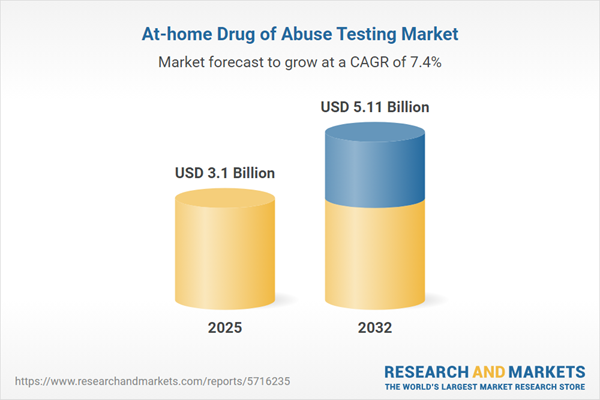Speak directly to the analyst to clarify any post sales queries you may have.
The at-home drug abuse testing market is evolving rapidly as privacy, technology, and compliance challenges require organizations to rethink sourcing and implementation. Senior leaders must adapt detection approaches as digital health tools and regulatory environments shift across regions and industries.
Market Snapshot: At-home Drug Abuse Testing Market
In 2024, the global at-home drug abuse testing market is valued at USD 2.88 billion, with projections indicating growth to USD 3.10 billion in 2025 and reaching USD 5.11 billion by 2032. This reflects a compound annual growth rate of 7.43%. Robust market expansion is supported by ongoing product innovation, adoption of advanced diagnostics, and widening competition driving broader product portfolios. Leadership teams are responding to continual regulatory change and rising competition by pursuing digital transformation and streamlining operations for increased resilience and agility.
Scope & Segmentation of the At-home Drug Abuse Testing Market
This report provides C-level executives and senior managers with an actionable structure for analyzing the multifaceted dynamics of the at-home drug abuse testing market, fostering informed risk assessment and opportunity identification. Market segmentation is designed to align with the priorities of enterprise buyers, healthcare providers, and distribution partners in diverse regulatory settings. Strategic insights in key segmentation areas include:
- Distribution Channels: Analysis covers direct sales, online ordering platforms, e-commerce marketplaces, and partnerships with pharmacy networks for maximizing reach and customer engagement.
- Test Types: Evaluation spans multi-panel screening kits versus targeted single-drug tests, allowing organizations to choose products that address either wide-ranging substance detection or focused compliance needs.
- Sample Types: Review includes hair, urine, saliva (dip card and swab), and sweat samples, balancing detection duration, regulatory requirements, and ease of use for different populations.
- Technology: The report benchmarks chromatography, digital and conventional lateral flow, and immunoassay-based platforms, guiding leaders in technology selection for both clinical-grade and consumer-grade applications.
- End Users: Perspectives span occupational health clinics, substance abuse treatment providers, privacy-conscious consumers, and retail pharmacies, supporting precise procurement strategies and service model development.
- Regions: Regional analysis covers the Americas, Europe, Asia-Pacific, the Middle East, and Africa, emphasizing regulatory trends in the U.S., Canada, the EU, China, India, Japan, Australia, and Southeast Asia for effective market entry and compliance planning.
Focused segmentation supports executive decisions around channel optimization, technology upgrades, and regional partnerships, as well as flexible adaptation to shifting compliance priorities.
Key Takeaways for Senior Decision Makers
- Advanced digital diagnostic solutions and integrated supply workflows enhance flexibility and scalability for enterprise, clinical, and consumer segments.
- Emphasizing privacy—from tamper-evident designs to secure user data practices—aligns with greater scrutiny by both customers and regulatory authorities.
- Clear compliance procedures and strong data management infrastructure are critical for building trust with institutional buyers and distribution partners across global markets.
- Pharmacy and telehealth partnerships contribute to supply stability, service scalability, and reduced distribution risks amid changing policies and consumer behaviors.
- Local sourcing initiatives and close supplier collaboration support dependable access and cost control, important in markets experiencing frequent demand or supply fluctuations.
Tariff Impact and Supply Chain Considerations
Forthcoming U.S. tariff adjustments in 2025 are prompting organizations to focus on domestic production, nearshoring, and regionally integrated supply chains. These changes are essential for addressing cost pressures and maintaining reliable distribution. Executives are refining procurement and inventory strategies to promote operational agility in response to evolving tariffs and regulatory requirements.
Methodology & Data Sources
The findings in this report are grounded in audited financial records, current regulatory analyses, detailed shipment tracking, and interviews with industry and compliance experts. This multi-source methodology enables senior teams to craft precise investment and operational responses with a high degree of confidence.
Why This At-home Drug Abuse Testing Market Report Matters
- Enables leaders to address evolving compliance standards and leverage digital diagnostic advancements while ensuring privacy and security.
- Supports resource allocation and partnership development as regulatory and user demands shift across regions and market tiers.
- Delivers benchmarking and guidance to streamline decision-making for investments and market positioning amid increasing complexity.
Conclusion
Organizations that prioritize digital innovation, strong compliance, and robust supply networks will position themselves for long-term market resilience. Agility and proactive monitoring are essential for effective adaptation in an evolving policy and competitive landscape.
Additional Product Information:
- Purchase of this report includes 1 year online access with quarterly updates.
- This report can be updated on request. Please contact our Customer Experience team using the Ask a Question widget on our website.
Table of Contents
3. Executive Summary
4. Market Overview
7. Cumulative Impact of Artificial Intelligence 2025
Companies Mentioned
The companies profiled in this At-home Drug of Abuse Testing market report include:- Laboratory Corporation of America Holdings
- Quest Diagnostics Incorporated
- Abbott Rapid Diagnostics
- Premier Biotech, LLC
- American Screening Corporation
- Express Diagnostics International, LLC
- Access Bio Inc.
- Diagnostic Automation/Cortez Diagnostics, Inc.
- Certest Biotec S.L.
- Nal von Minden GmbH
Table Information
| Report Attribute | Details |
|---|---|
| No. of Pages | 194 |
| Published | October 2025 |
| Forecast Period | 2025 - 2032 |
| Estimated Market Value ( USD | $ 3.1 Billion |
| Forecasted Market Value ( USD | $ 5.11 Billion |
| Compound Annual Growth Rate | 7.4% |
| Regions Covered | Global |
| No. of Companies Mentioned | 11 |









